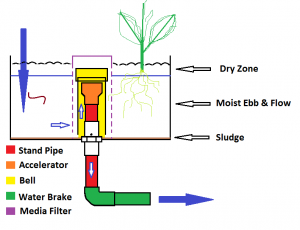Bell Siphon

A bell siphon is an automatic siphon that allows you to completely fill and then drain a grow bed on a timer. The timing comes from how fast you add water into the system. Once the bed is full, it creates a siphon that drains all the way down to the bottom of the bed. At the bottom it sucks up air, breaks the siphon and the process starts all over.
Usually water constantly floods the siphon apparatus and when it fills up, air pressure lifts water from the bottom of the tank as a siphon starts, draining it without other sources of power until it gulps air, breaking the siphon.
The other primary type of automatic siphon is the loop siphon. All of them use atmospheric pressure to “start” the siphon, and when water has been emptied, the suction is broken, disabling the siphon until the next fill up.
Live graphic explaining the physics of the bell siphon: Youtube Bell Siphon
Bell Siphon Troubleshooting
Each bell siphon is adjusted to your particular grow bed, pump rates, and water break size. Here are some tips to help you adjust your bell siphon:
Siphon never starts or just trickles:
- Standpipe must be level. Brake should be level or with only a slight downward angle (to speed up the drain only slightly)
- Water inflow is not fast enough, or outflow is too fast. Adjust brake to throttle water drain speed so stand pipe fills up with water (longer, sharper turn, add an elbow), or increase water flow, or increase size of accelerator (the flange) to dump more water down the standpipe so it seals and makes a clean siphon start.
- Bell height over standpipe might be too high. See if gravel or grow media has lifted the bell at all. You might benefit from placing a large stone on top of your cap to keep it forced down.
- If you are using a snorkel to break the suction, make sure it is airtight, and the cap of the bell must also be air tight.
Siphon starts but then trickles, never truly shuts off:
- Water in and out is too balanced or you have too much water input and not enough drain.
- Reduce accelerator (the flange), or reduce inflow, or shorten brake or remove an elbow. The crenellations on the bell might also be too low and buried in the sludge layer. It must have air to suck up to “break” the siphon so it can completely refill.
- Adjust the drain pieces to have longer or shorter horizontal pieces.
- Bell width might be too small.
- Bell height over standpipe might be too small (1/2” or more depending on standpipe width)
- If you have a large grow bed, the water level might drop too slow to suck up air and break suction. See: Slow Drain Bell Siphon as a way to add a breather tube and a small cup that forces a burp.
- The snorkel, or breather, might be jammed with grow media, a worm, or bio matter. It should be clear and freely allow air to be sucked in so the suction can officially break.
Siphon never fully drains system:
- Too much brake or water input too fast. Make sure your break is shorter, or angled down so water flows out faster. Reduce 90 deg elbows and use 2x45deg instead, or remove elbows completely.
- Notice in the drawing how roots are invading the media filter. Taking care of things like this are part of the regular maintenance and you should inspect your bell siphons at least weekly for slime build up, solid waste, or things like root growth.
See Also:
- Alternative Auto Siphon Design 100% reliable, no fuss autosiphon
- Bell Siphon Study by the University of Hawaii best practices for bell siphons
- Affnan’s Bell Siphon Experiments
I figured out one more way to fix the problem of the drainage not starting. I seemed to have pressure building up at the top of the bell, even though I used no trap at the bottom which some people (erroneously i think) recommend. So I took an 18 inch piece of 1/4 inch poly tubing and shoved it down through the 1 inch standpipe, and around the bend, and let it stick up past the top of the standpipe, all the way to the inside top of the bell. this evacuates air right at the beginning, and will even continue to do so by venturi action, but since the drain pipe quickly fills up with water it will not allow air to enter the chamber until the drainage flow has stopped anyway